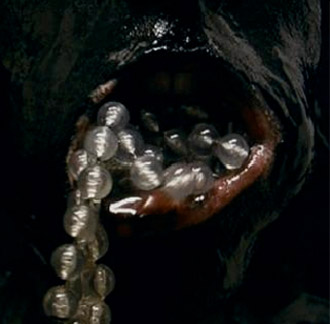
In 2009, the réattu museum's exhibition, chambres d’écho offered a new reading of the photography collection, in which several guest works - mainly sculptures - brought their own perspective to bear. Questioning, prolonging or provoking, the result was a little like a sketch of the ideal collection....
Center of the "phylacteries room," resonating with the work of Corinne Mercadier, the Vladimir Skoda planetary disks had found more than their natural place in a building that has always been dedicated to the power of the elements, whether wind, water or light ... Consisting of 4 elements immemorial number who speaks immediately from orientation, this work displays on the ground large concave discs, long polished, among which shines a tiny drop of mercury . Combining the geometry sketch to the concentration of a paradoxical matter, pushing to the extreme poetic opposites and contrasts - dense, fluid, matte, air, chopped, elusive - Skoda operates as an alchemist, somewhere between the rule and chaos.
Frédéric Rhodes' production of furniture is complementary to his main activity as an architect, as well as being a powerful outlet for freedom and experimentation. Clearly acknowledging the influences of constructivist design and architecture, he sets out to apply a three-dimensional cubist vision to his items of furniture.
Taking up his place in the collections in 1989 following the purchase of Fauteuil 2+2, Frédéric Rhodes will make yet another appearance in the Réattu Museum story, thanks to his gift of a recent table (2009), Table 8. Originally designed as his own work desk, this prototype - like his armchair of 1989 - is a concentration of the artist's research and "obsessions": a mathematical harmony of proportion, the application of the Golden Ratio - which crops up throughout his work - the use of noble materials. This donation adds another facet to one of the museum's more singular collections, made up of contemporary furniture prototypes.
The friendly and professional relationship between Pierre Jahan and Jean Cocteau began in 1941, when the photographer makes a report about writers residing in the Palais Royal in Paris . Since then, Jahan dreams to illustrate one of the most famous poems of Cocteau, Plain-Chant, dating from 1923. After Cocteau agreement, it is for him to find the ideal couple for shooting but he ultimately decides to let his female model the freedom to choose his partner. Genuine illustrator, Jahan does not take liberties with the text. On the contrary, during the sessions, the photographer read, before each shot, the stanza he wants to illustrate. Fifty images have emerged during these sessions, Jahan constantly consulting Cocteau. But in 1947, the time is the modesty an neither Cocteau nor Jahan can find a publisher for this work considered scandalous. It was not until 1988 that the Michèle Chomette gallery publishes this work , printing thirty copies, containing twelve photograph prints made in 1986 by Pierre Jahan from its 1947 negatives. By entering in the collections - where appear major figures of French "humanist" photography , René- Jacques, Doisneau, Ronis, Boubat Dieuzaide - Pierre Jahan joined his friend and mentor Emmanuel Sougez (donation Cingria Hélène, 1965). In addition to the extraordinary quality of this series, this acquisition refers to the innovative action actors of Le Rectangle group, then extended by Le groupe des quinze in 1946, whose aim was, from first-class productions, defense and dissemination of photography as an artistic creation.
Luca Gilli is the youngest of the Reggio Emilia photographers centered on the emblematic figure of Vasco Ascolini, a group which also includes Cesare Di Liborio. For twenty years, the Réattu Museum has been following the development of this movement, closely based in the area around Reggio Emilia, which is very similar to Arles in terms of geographical features.

The video, Barroco was created by Mélina Jaouen in Arles in 2010. The piece formed part of her final year studies at the Ecole Nationale Supérieure de la Photographie, receiving a distinction and a special commendation from the jury.
On a pretty tight format, this piece is immediately reported by both its expressive power and economy of means. It combines with astonishing mastery in a young author registers painting , sculpture and performance , serving an almost hypnotic writing in its relation to time and body.
" Barroco means pearl of irregular shape .
It is a work largely performative seeking an enactment of the body in order to consider the possibilities of metamorphosis and bodily limits. Through painting and clay, the face becomes sculpture and has the appearance of a mask.
Human thing twists and distends, she struggles between dilution and emergence. Fragmentation, fragmentation of the body, reduced to the mouth, becomes as sex organ passage between interiority and exteriority of the body, strange and monstrous fish. This mouth is fascinating and repulsive at the same time . Chewing and rejection of these beads is both a birth and vomiting. There is a tilting movement between the outside and inside of the body . Initially, the beads out of the mouth , becomes a kind of carving of the body . Then slides into another space, as if it came under water, or rather as if rocked inside the body. This impression flip alters our perception beads that become particles , strange amphibian eggs , organs proliferate and off , escape from the body ( M. Jaouen ) "